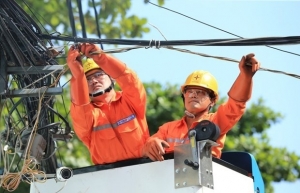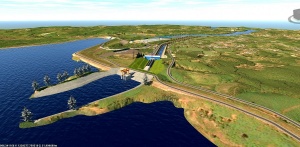Hydropower must be utilised to develop energy sources
 |
| Hydropower must be utilised to develop energy sources, illustration photo/ Source: freepik.com |
The National Energy Master Plan, announced by the Ministry of Industry and Trade (MoIT) on August 9, virtually ignores the role of hydropower in reaching the required proportion of renewables in the energy mix, according to Nguyen Huy Hoach, secretary-general at the Vietnam Clean Energy Association.
“Hydropower is a flexible power generation solution with low operating costs and carbon emissions,” said Hoach. “It plays an important role in the development trend of renewable energy, including solar energy and wind energy. It is indispensable to replace fossil energy and reduce greenhouse gas emissions gradually. As of the end of 2022, solar power and wind power made up 26.4 per cent of the installed power capacity.”
Renewable energy is set to account for 15-20 per cent of Vietnam’s power supply by 2030 and about 80-85 per cent by 2050. The plan estimates that Vietnam’s total energy demand is expected to hit 107 million tonnes of oil-equivalent by 2030 and 165-184 million tonnes of oil-equivalent by 2050.
The increase in peak capacity can come from the expansion of the existing hydroelectric plants and the construction of low-head hydroelectric power and storage hydropower plants, according to Hoach.
Hoach said that Vietnam can exploit the hydropower capacity of around 120 billion kWh per year as the hydropower reserve of 300 billion kWh per year is a theoretical estimate. Meanwhile, the economic-technical capacity is estimated at 80-100 billion kWh/year.
Vietnam has faced a severe shortage of electricity this summer. “Power outages in the north in May and June have disrupted production and cost Vietnam about $1.4 billion, accounting for 0.3 per cent of its GDP,” said Dorsati Madani, senior economist at the World Bank, on August 10.
Vietnam’s imbalance of power supply is because the northern region mainly relies on hydropower and coal for electricity, both of which have been short of materials, leading to delays in energy production and distribution. The limited capacity for distribution makes it difficult for the area to access the excess energy supply in southern Vietnam, of around 20GW.
Vietnam’s energy industry advocates diversification of power sources. However, many investors cannot make new investment decisions because there is no fresh policy on price mechanisms.
Currently, only single hydropower plants of up to 30MW capacity each will be eligible for the avoided cost tariff (ACT) mechanism, said Dinh Ngoc Khac, representative of Hong Ha Energy Development and Investment Company.
Ry Ninh 2 Hydropower Plant has stopped applying the ACT mechanism since the beginning of 2023, and the plant is still waiting for a new mechanism.
“Hydroelectric power plants will find it difficult to proactively make their business plan as they have to comply with changing regulations each year,” Khac said. “We can’t take advantage of this affordable power source and make efficient use of the equipment, and so waste resources.”
The ACT, first issued in 2008 and replaced in 2014, encourages investment in small hydropower projects on the principle of ensuring fairness and transparency between buyers and sellers, minimising environmental pollution, and ensuring social security.
With some hydropower plants newly built and expanded to match the power structure of the national system, such as the Tri An hydropower project in the southern province of Dong Nai and the Bac Ai storage hydroelectric project in the central province of Ninh Thuan, many investors hope that the mechanism for developing a competitive electricity market will soon be completed.
| l The total capacity of hydropower, including expanded and newly-built plants, is expected to reach around 29,350MW by 2030. This figure will be more than 36,000MW by 2050, mainly from small hydropower, according to the Power Development Plan VIII. l Vietnam has built and put into operation hydropower at around 22,600MW with annual electricity output reaching 75-85 billion kWh per cent annually. In 2022, thanks to favourable weather conditions, the power output from hydropower reached just over 95 billion kWh. |
 | No more power shortage in northern region: Official Since the end of June, the water levels in hydropower reservoirs have been rising and technical problems of a number of thermopower turbines solved, ensuring a basically sufficient power supply in the north, said Deputy Minister of Industry and Trade Do Thang Hai. |
 | KfW bank and EVN set to expand Tri An hydropower plant Germany's KfW Development Bank and Vietnam Electricity (EVN) have agreed on terms for the expansion of the Tri An Hydropower Plant, with the plan to finance the project directly through KfW, circumventing the need for government guarantees. |
What the stars mean:
★ Poor ★ ★ Promising ★★★ Good ★★★★ Very good ★★★★★ Exceptional
Related Contents
Latest News
More News
- Heavy industries set for pilot greenhouse gas quotas (December 25, 2025 | 10:00)
- Swedfund invests in MSME growth and climate action in Vietnam (December 19, 2025 | 11:42)
- GreenYellow brings solar energy to light up remote schools in Tuyen Quang province (December 19, 2025 | 08:00)
- Charge+, Grab partner to develop EV charging network in Vietnam (December 18, 2025 | 17:11)
- Linking sci-tech and innovation to Vietnam’s net-zero future (December 18, 2025 | 14:31)
- Driving double-digit growth through green and circular transformation in Vietnam (December 17, 2025 | 09:00)
- Standard Chartered and ACCA deepen collaboration to develop Vietnam’s talent for a sustainable future (December 15, 2025 | 18:18)
- Schaeffler reports strong early output from Dong Nai solar project (December 12, 2025 | 15:16)
- Forestry conference highlights biodiversity and sustainability goals (December 09, 2025 | 13:35)
- Home Credit honoured among top 10 sustainable companies in trade and services (December 09, 2025 | 12:18)

 Tag:
Tag:



















 Mobile Version
Mobile Version